|
Since
the introduction of Ford's styleside pickup in 1957, the bed
and cab were two separate components, with a gap between
them. This allowed for the cab and bed to twist
independently as the truck was loaded or was crossing rough
terrain. These were work trucks...plain and simple.
However,
Ford planners took notice of the fact that by the early 1960s, light-truck buyers
were purchasing pickups for light-duty use and even just as personal
transportation. They determined that by combining the
cab and bed into a single assembly (which they called the 'integrated body'), the truck
required fewer stampings, fewer welds and was less
complicated to paint. It also increase load space by 16
percent.
So in
1961, Ford introduced the 'unibody' (as it was called by
the public, even though technically it wasn't) (TYPE 1), which was
offered in F100 and F250 2WD models and was the only
styleside versions available for those two models. However,
both models were also available with a traditional flareside
bed in 6' and 8' lengths.
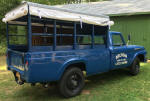
1961 F-350 w/ 9-ft.
Styleside Express bed |
Soon
after the unibody's introduction however, reports started
to trickle in that over-loading the bed in some cases would
cause the frame to twist enough that the doors would be
difficult to open. Urban legend even says that people
actually fell out of the cabs after doors popped open (since
lap-type seatbelts were an option that most trucks weren't
equipped with), but there have been no substantiated reports
of this happening. (In
fact, Ford actually prided themselves on double-latching "
Lifeguard" door locks.) There is some
speculation that the single-wall design of the unibody
truck's bed area contributed in part to the problem of the
frame twisting when the bed was loaded down, and that
perhaps a double-wall bed design would have provided more
rigidity.
Regardless of the cause, to address the complaints, Ford
pushed an alternate styleside bed into production for the
'62 model year, utilizing the basic design and appearance of
the '57-'60 'Fridge' bed and which was already being used on the '61
F350 (TYPE 2). However, since the '61 F100 and F250 wheelbases had
each increased by 4", the actual '57-'60 bed wouldn't fit
the new chassis, so the 'new' styleside bed (based on the
older '57-'60 design) would receive a few tweaks. (See 'Construction'
below.)
This
bed would make it's official debut for the '62 model year as an
available styleside bed option for the F100 and F250, and
has since been dubbed the 'wrongbed' by Ford truck fans,
because the character line of the bed doesn't match up with
the line of the cab.
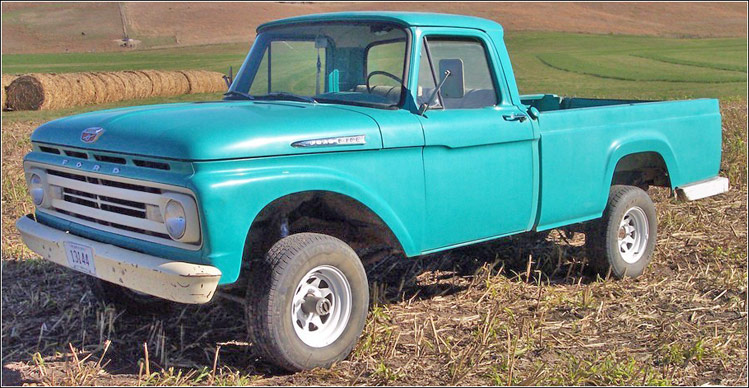
1962 F100 4x4
|
My research through the Ford
Trucks Master Parts Catalogs seem to indicate
that even though there were SEVEN different
wheelbase lengths on Slick-era light-duty trucks
(or nine if you count the crewcabs), Ford didn't
make a version for each specific wheelbase in
which a wrongbed was available. In actuality,
there were only three different-length
'wrongbed' beds used, as shown in this chart. As
you can see, they used the same bed for 120" and
122" WB trucks:
|
'WRONGBED'
APPLICATION CHART |
|
SWB |
114" |
1962-63 F100
4x2 |
|
LWB |
120" |
1962-1964
F250 4x4 |
|
122" |
1962-1963
F100/F250 4x2 |
|
9-FOOT |
132" |
1961-1966
F350 |
|
|
|
WHEELBASE CHART
All
available wheelbases during the '61-'66
era
Italics: wrongbed not available |
114": 1961-64 F100 4x2
115": 1965-66 F100 4x2, 1966 F100 4x4
120": 1961-1966 F100/F250 4x4
122": 1961-1963 F100/F250 4x2
128": 1964 F100/F250 4x2
129": 1965-66 F100/F250 4x2
132": 1961-66 F350 |
NOTE 1: 1957-1960
truck WB: 110", 118", 130"
NOTE 2: The MPC show the '64 F350
as having a 131" WB, but this is a typo.
All F350s from '61-'66 had a 132" WB.
NOTE 3: Chart does not include 147"
1965-66 F250 crewcab or 152" 1965-66
F350 crewcab |
|
Ford would discontinue the 'unibody'
truck around the middle of the 1963 model year
(January/February 1963). The 'wrongbed' bed was available as
an alternative to the unibody style starting in late 1962
All 1961-1965 F100
4WD and
all '61-'66 F250 4WD
trucks had a wheelbase of 120", and since
the Fridge-style 'wrongbed' was the only separate styleside pickup
bed Ford had available to fit that wheelbase, starting in
1962, these trucks got the
'wrongbed' by default when a styleside bed was requested.
In 1964, Ford increased the
wheelbase on the F100 and F250 2WD LWB trucks by
six inches each, meaning they finally had to
design a bed which not only matched the new
wheelbase figures, but also included body lines
which matched the cab to fit the new chassis.
And since they were designing new LWB beds to
match the new wheelbase figures, they went and
and made SWB versions of the new double-wall
styleside bed as well (TYPE 3). However, it was only installed on 2WD trucks and the '66 4WD.
In
1966, Ford finally offered a short wheelbase 115" WB F100
4x4, matching that of the 2WD wheelbase, so it too got the
new Type 3 styleside box.
This
new double-wall bed design was only installed on 1964-66 F100/250
2WD and 1966 F100 LWB 4WD.
All other 1961-66 Stylesides except Uni's used the
Fridge-style beds.

Frequently Asked Questions
-
Q: The wrongbed
just looks strange! Why wouldn't Ford invest the time to
develop a bed which lined up properly with the cab body
line from the start?
A: When Ford released the Integrated Body (unibody)
truck in '61, they were banking on its success. When it
became obvious to them that it wasn't doing as well as
they'd hoped, mainly due to the previously-mentioned
body twist issues, and also because they suddenly found
a lot of buyers wanted the cab and body separate which
they hadn't anticipated, they were forced to do what they
could in a short amount of time. Since many of the
needed parts and dies from the Type 2 bed were already available, there was
much less monetary investment to adapt the '57-'60 box
for the limited number of pickups with a separate
styleside box being ordered.
The people who did buy these trucks back then were
working people...there was very little need for
"pretty". These trucks were made for work, plain and
simple. In the case of 4WDs, the long bed with short
120" wheelbase allowed less "high centering" and " breakover
angles", as well as optimal clearance for large tires/
wheels. And the it's been suggested that buyers of
'wrongbed' trucks did a little bit of a price break over
the cost of a unibody truck.
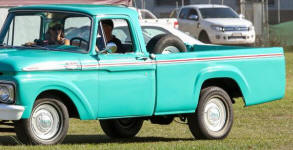 |
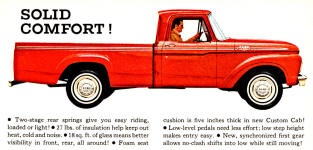 |
|
Ford went to great pains to
minimize the styling differences between the cab
and the Type 2 bed, both in production and
advertising. In 98% of their advertising, if a
'wrongbed' is pictured at all, like in the 1963
magazine advertisement above right (usually it's
simply mentioned as being available), they'd
always picture a Custom Cab truck which came
with bright side trim, which tended to make the
difference much less noticeable. |
- Q: Will a new-style
64-66 box bolt up in place of a 61-63 wrongbed without modifications?
A: Short bed, yes... because the wheelbase is the
same. Long bed, no...the long bed
wheelbase is different between 1961-63 and 1964-66 2WD
trucks.
-
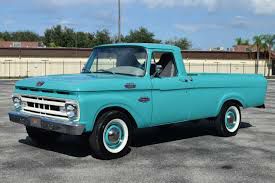 Q:
Will a '61-'63 unibed door bolt up to a non-unibed
truck? Q:
Will a '61-'63 unibed door bolt up to a non-unibed
truck?
A: Cab body lines line up, they just won't carry
on the uniform angularity of the unibody line or the
parallellity of the
later Styleside character line. The picture at right
shows how with the stepped door instead of the
straight-line unibody door how it makes the truck look
"bent", like some giant stepped on the very back of the
truck.
On a related note, the angled off-of-horizontal
character line of the unibed necessitated different end
caps for the tail lamp areas of the long versus short
unis. This is a fact some learned "the hard way".
|